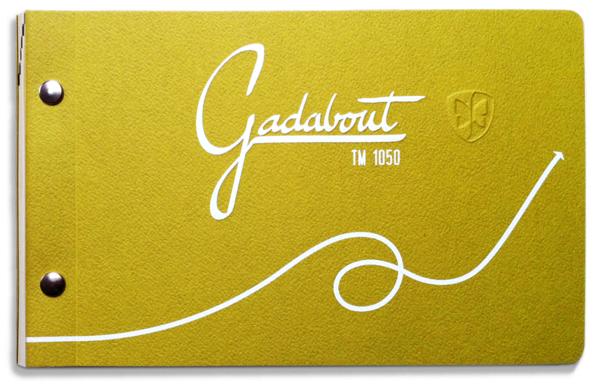This elegant, fun, costly, thin, pale green book says it’s the owner’s manual for a time machine, the Gadabout TM 1050. It’s a pitch-perfect and perfectly consistent imitation of a manual you might really own for a car or a blender, though its carefully retro design (rounded pages, slim fonts, black and white illustrations) makes it look more like a manual that your parents or grandparents might have owned. It’s a gag gift, a prompt for fan-fiction, an excuse to imagine the short jaunts you might take (forgot a birthday? no problem!) if the manual came with the product whose use it describes. There are guidelines for regular maintenance; a warranty voucher that you can clip out and send back; safety instructions and directions for troubleshooting; even happy talk about how this model and brand rise above their competitors to become “the most economical choice for all household errands and short journeys,” thanks to “fully automatic space-time configurations and patented Chrono-matic Accuracy.” Page after page of lists and explanations mixes banal items shared with DeSoto sedans and Sears refrigerators (parking brake, ice dispenser) and phrases that make no sense outside of science fiction (“Never, ever attempt to operate the unit if the dimensional collapse has malfunctioned”).
A deadpan success in its writing, the manual stands out the more for its graphic design, black and white sketches, and diagrams from the age of Ma Bell. Like other retro-look things that evoke the same era, it invites us to remember, and to revive, the optimism that came with mid-century science fiction and the early space race. The remote-displacement control looks like an old thermostat dial; the longitude knob—to be used when you “set the location of your desired space-time destination”—looks like a joystick from an early video game. The Gadabout also sports analog clocks and a ’50s-style dashboard console radio, and there’s a compass, an ashtray dump, even a hand-crank, appropriately diagrammed “to allow for manual cranking of the critical core mass.”
Close as it is in so many ways to real manuals for automobiles and vacuum cleaners and so on, manuals that we might stow in a glove compartment or ignore, the manual still insists on its uselessness: it can instruct us only in what to imagine. It therefore says something not just about time travel, science fiction, and nostalgia, but also about genre, which is to say expectations: where we get them and how they control what we read. We get our expectations from the language that writers use, of course, but we also get them from format, from page layout and graphic design, and from the context in which we acquire or learn about a book.
Because there’s so much banality here on the one hand, and so much (made-up) engineers’ jargon on the other, you have to look closely to find the imaginative language and the hidden jokes, themselves dependent on what we know about those surprisingly closely linked genres called “owner’s manual” and “science fiction”—the first parodied, the second created (by means of the first) right here.A page of small print warns,“Do not throw objects at or near time machine” and “Do not allow pets or children to chew on controls,” but also “Do not tie pets to exterior of time machine before departure” (future Romneys take note),“Do not use time machine to transport religious reliquaries,” and “Do not operate on a leap day.”
The closer you look, the more jokes you find. A guide to the TM 1050’s thirteen fuses distinguishes each by color: Sunshine, Blonde, Lemon, Saffron. In “Troubleshooting,” the list of problems includes “Time runs with more or less than 24 hours per day” (if so, most likely the “timing belt is worn”), “You have arrived at your destination to find there are two of you,” and “You have lost an item from the present in the past, or have taken an item from the future into the present.” If you encounter that last problem, you must “check to see if the Novikov self-consistency pinion is still in the consistent causal loop. If it is, no action is necessary, you will find that the item’s history will still reflect this mistaken transport (i.e. the person in the past who has found your object will turn out to be the one who returns it to you).” Also,“Traveling past the end of time may void your warranty.”
Time travel—so the manual suggests—isn’t just one more science-fictional motif. It’s one way that science fiction represents itself, since through it we “visit” the future; if we prefer to visit the past, to imagine the future through old-school graphic design, perhaps that preference speaks to our own nostalgia—our sense that the future isn’t what it once was, that new technology can’t help anymore. What survive, after the decline of futurist optimism, are the genres that that optimism helped to create: science fiction of a certain classic sort, but also the owner’s manual itself, with its promise that we can all master the workings of our complicated new apparatuses. The Cudworth-Hooper manual is a memorial to that promise as well. It belongs to a genre and it parodies that genre, but it also shows how we can make any genre a literary one, an excuse for literary invention, once we can detach its features from practical use.





